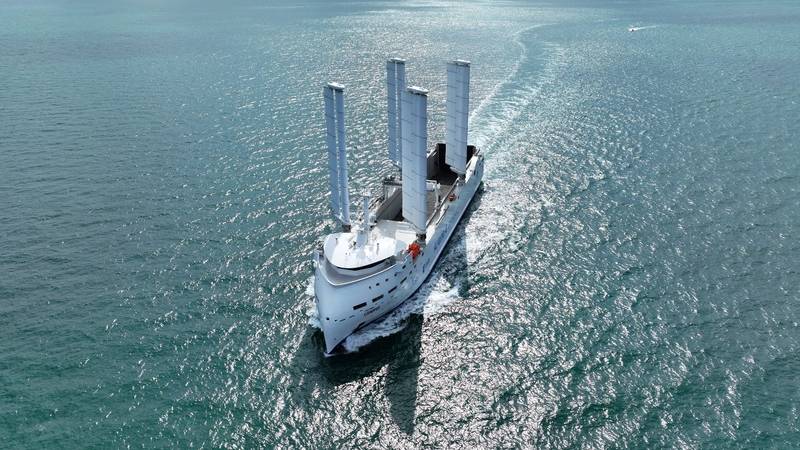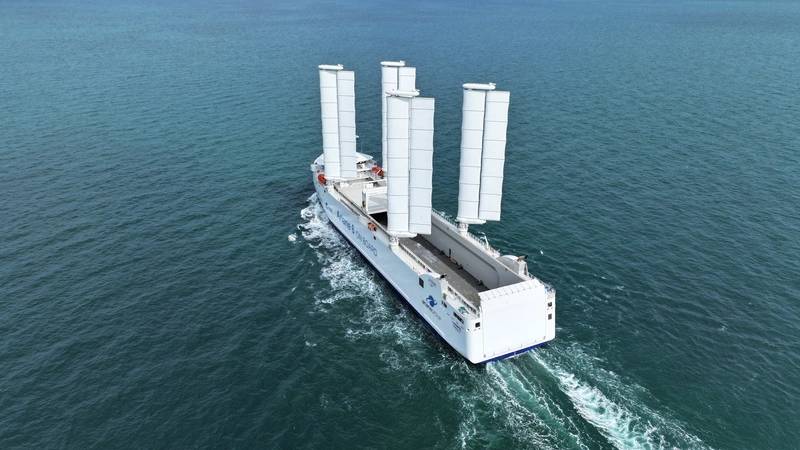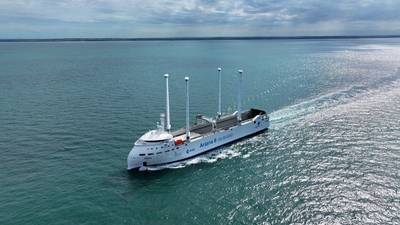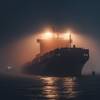Americas Cup Innovation & a Carbon-Free Shipping Future
The Golden Gate Yacht Club (GGYC) represented by BMW Oracle Racing and the Société Nautique de Genève (SNG), the Americas Cup defending champion, represented by Team Alinghi were entwined in a 2.5-year legal battle over multiple court cases, including hearings in the New York Supreme Court and the Appellate Division of the New York Supreme Court, prior to the 33rd edition of the race, due to take place in 2010.
The parties disagreed about the location, format, and restrictions on boat design, all of which were changed by the courts prior to the race. The lifting of restrictions on boat design gave BMW Oracle Racing the possibility to create the most advanced carbon fiber trimaran the world had ever seen, which, with a team of skilled and experienced professional sailors went onto claim the Americas Cup for an American team for the first time since 1992.
The February 2010 one-on-one match race was initially hard fought, but in the end, the United States of America could be proud of BMW Oracle Racing and its success in bringing the Americas Cup home. It was, however, a unique new rigid wingsail design based on an aircraft wing that propelled Ellison’s high-tech trimaran across the finish line eight and a half minutes before the defenders showed up in the Alinghi 5 catamaran, fitted with more orthodox, albeit race-bred, sails.
The use of a rigid wingsail contributed to the biggest Americas Cup win since 1988, which is quite a legacy. But the adaptation and commercialization for merchant ships of that original wingsail design since 2018 by French tech startup AYRO has the potential to leave a much larger legacy; by providing a new approach to wind assisted propulsion that can significantly reduce the impact of modern shipping on the environment.
 Image © AYRO UNI PROD
Image © AYRO UNI PROD
The Inception of OceanWings
The original Americas Cup rigid two-element mainsail was pushed by the design team and renowned naval architecture firm VPLP Design, along with its co-founder Marc Van Peteghem, were tasked with the job of integrating it on the BMW Oracle Racing trimaran. Drawing inspiration from his experience and achievement, Marc embarked on a journey to adapt this high-performance wind energy system for commercial vessels. His vision was clear: to reduce the use of fossil fuels and, by extension, shrink the carbon footprint of shipping.
This vision resulted in Marc becoming the co-founder of AYRO in 2018, and the subsequent birth of OceanWings, the company’s unique wingsail solution engineered to combat the climate-related challenges that loom over the maritime industry. While five years in the making, OceanWings arrive at a time when regulatory pressures are mounting to accelerate the shift towards sustainability within the sector.
At the heart of AYRO's pioneering wingsail technology lies a dynamic interplay between primary and secondary sail components. It's a symphony of movement and interaction that sets OceanWings apart, eclipsing the performance of conventional sails and single element wing-sails. The key is a cleverly designed slot gap that orchestrates the flow of air between these two sail elements, igniting a powerful acceleration along the wing's leeward edge, known as the extrados. The principle takes a cue from aircraft wings in motion and the result is balance and incredible performance even at narrow apparent wind angles.
This is crucial for ships in motion, where apparent wind takes precedence over true wind. AYRO’s wingsails generate propulsive force even when the apparent wind angle is as low as five degrees, so they can adapt to 95% of conditions found at sea. And in that remaining 5%, the system efficiently mitigates the added drag from inactive wing-sails, automatically switching to flag mode to ensure minimal impact on the vessel and enable safe operations and navigation under engines alone. Critically, despite originally being developed to be handled by some of the world’s most skilled and experienced yachtsmen, OceanWings operation is fully automated, requiring a ship’s crew only for supervision.
Scaling Down for Commercial Ops
While technology or ideas coming from the yachting world to ships would normally mean a scale up effort, the work to make OceanWings suitable for commercial vessels was actually a scale down of the original design. The wingsail on BMW Oracle Racing’s 2010 trimaran was an incredible 68 meters tall.
Today’s largest OceanWings are 37 meters tall with a projected area of 363 square meters. Steel ships are of course much heavier than a state-of-the-art carbon fiber tri-maran, however there is more real estate, so AYRO was able to build a smaller wing under the expectation that at least two and anywhere up to eight would be deployed. Working out the complex interplay between multiple wingsails was a key aspect in the development of OceanWings.
This research was also supported by efforts made in the design of the Canopée, which is the first ship to use OceanWings wingsails on a commercial voyage. Working closely alongside the Canopée’s owner Jifmar Offshore Services, the VPLP Design team thoroughly analyzed the vessel's behavior in relation to the use of its four OceanWings. Their goals went beyond simply identifying the optimal wing positions; they delved into the forefront of Computational Fluid Dynamics (CFD) advancements, encompassing the detailed modelling of the intricate interaction among multiple OceanWings.
Comparing the performance assessment of a single wingsail on a vessel differs from evaluating the performance of a more intricate configuration comprising multiple wing-sails. Further insights from the Energy Observer catamaran – an OceanWings testbed that has travelled more than 20,000 nautical miles under wingsail propulsion since 2019 has played a role in enhancing the control algorithms that govern the automation of the wing-sails.
Hybrid Propulsion is the Way Forward
Fast forward to October 2023 and the Canopée sets sail for French Guiana on its maiden voyage – marking it as the first modern wind assisted modern ship in commercial operations. Its job is to deliver Ariane 6 rocket parts to the launch site, so it will spend most of its life on a fixed trans-Atlantic route between Europe and South America.
Modelling, and data from Energy Observer and live sea trials aboard Canopée have put the fuel consumption and GHG emissions savings at around 30%, with peaks in excess of 50% in favorable wind conditions. That’s 30% less fuel and 30% less carbon when measured against a similar vessel using heavy fuel oil on the same route. These savings are available now.
While it’s possible for the Canopée to voyage at more than 9 knots just using its wingsails, scenarios where this is a viable mode of operation will be few and far between. Instead, the value of its OceanWings comes from using the wind to reduce the work its engines need to do, with the result being a very positive impact on operational efficiency.
This hybrid assisted approach will be necessary going forward if the shipping sector is to ever become truly carbon neutral. Future fuels, such as methanol will play a significant role, but their mainstream availability will likely be limited for several decades, and they may cost four to six times more than heavy fuel oil does today. The financial factors will certainly slow adoption, but the cost challenges can be mitigated when wind power enters the equation. In fact, AYRO’s research shows that OceanWings are capable of delivering 50% savings on fuel consumption, which would be a huge advantage for ship owners when choosing, or finally being forced to adopt costly future fuels like methanol.
Reaching True Decarbonization
Mitigating the far-reaching consequences of global warming stands as one of humanity's most pressing challenges. Currently, ships are responsible for about 3% of total carbon emissions and are expected to represent up to 17% of human CO² emissions by 2050 if no action is taken. Fortunately, the industry has already been set on a carbon free trajectory.
In July 2023, IMO Member States adopted the 2023 IMO Strategy on Reduction of Greenhouse Gas (GHG) emissions from Ships, with enhanced targets including a common ambition to reach net-zero GHG emissions from international shipping by or around, i.e. close to 2050, a commitment to ensure an uptake of alternative zero and near-zero GHG fuels by 2030, as well as indicative check-points for international shipping to reach net-zero GHG emissions for 2030 (by at least 20%, striving for 30%) and 2040 (by at least 70%, striving for 80%).
Wind assisted propulsion combined with future fuels can steer the maritime world towards a more sustainable and environmentally friendly future. But it’s important that the conversation includes the world’s largest source of free energy, the wind.
By promoting wind propulsion as the technology available today that can unlock the most drastic savings, it’s possible to look positively and imagine that the IMOs 2030 target could be met. Action on wind propulsion now will build a platform for making future fuels more viable and wind assisted hybrid propulsion should easily help the industry reach the 2040 target as ships begin to reduce their reliance on heavy fuel oil.
After this, with further developments and innovations from new ship designs to more digitalization combined with wind power and future fuels, true decarbonization in shipping by 2050 starts to look entirely plausible. And likely not a moment too soon. Image © AYRO UNI PROD
Image © AYRO UNI PROD











